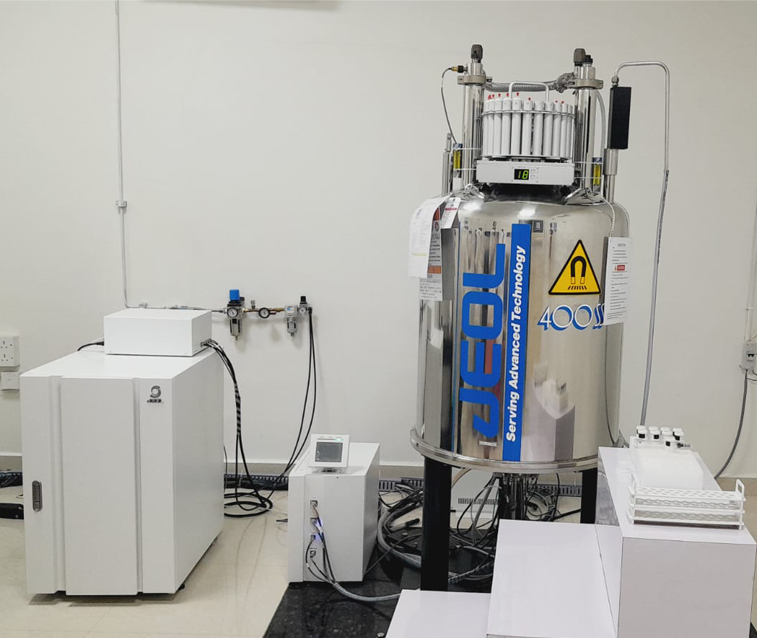400 MHz FT-NMR Spectrometer
Model Name: JNM-ECZL400S
Nuclear magnetic resonance spectroscopy (NMR) is the most powerful technique for
determining the structure of organic compounds. NMR is a physical phenomenon in which
nuclei in a magnetic field absorb and re-emit electromagnetic radiation. This energy is at specific
resonance frequency which depends on strength of magnetic field.
NMR Spectroscopy determines the physical and chemical properties of atoms or the molecules in which they are contained nucleus.
NMR Spectroscopy determines the physical and chemical properties of atoms or the molecules in which they are contained nucleus.
NMR spectrum gives the following information
-
 The number of peaks indicates different types of nucleus.
The number of peaks indicates different types of nucleus. -
 The location of the peak indicates the type of nucleus and chemical environment.
The location of the peak indicates the type of nucleus and chemical environment. -
 The relative areas of the peaks give the relative number of each type of nucleus.
The relative areas of the peaks give the relative number of each type of nucleus. -
 Disruption in the peak, indicates that affected nucleuses from each other
Disruption in the peak, indicates that affected nucleuses from each other
1D NMR can be analysed
-
 One-dimensional nuclear magnetic resonance spectroscopy (1D NMR) is a set of nuclear
magnetic resonance spectroscopy methods.
1H NMR, 13C NMR, 31P NMR, 19F NMR, 11B NMR, 15N NMR, 17O NMR, APT, DEPT, D2O
exchange, Quantitative-NMR, NOE (Nuclear Over-Hauser effect), Wet NMR, Deuterium
NMR, Selective decoupling,
One-dimensional nuclear magnetic resonance spectroscopy (1D NMR) is a set of nuclear
magnetic resonance spectroscopy methods.
1H NMR, 13C NMR, 31P NMR, 19F NMR, 11B NMR, 15N NMR, 17O NMR, APT, DEPT, D2O
exchange, Quantitative-NMR, NOE (Nuclear Over-Hauser effect), Wet NMR, Deuterium
NMR, Selective decoupling,
2D NMR can be analysed
-
 Two-dimensional nuclear magnetic resonance spectroscopy (2D NMR) is a set of nuclear
magnetic resonance spectroscopy (NMR) methods which give data plotted in a space defined by
two frequency axes rather than one. Two-dimensional NMR spectra provide more information
about a molecule than one-dimensional NMR spectra and are especially useful in determining
the structure of a molecule.
COSY, NOESY, ROESY, TOCSY, HMBC, HMQC, HSQC and etc.
Two-dimensional nuclear magnetic resonance spectroscopy (2D NMR) is a set of nuclear
magnetic resonance spectroscopy (NMR) methods which give data plotted in a space defined by
two frequency axes rather than one. Two-dimensional NMR spectra provide more information
about a molecule than one-dimensional NMR spectra and are especially useful in determining
the structure of a molecule.
COSY, NOESY, ROESY, TOCSY, HMBC, HMQC, HSQC and etc.
Homonuclear through-bond correlation methods
-
 In these methods, magnetization transfer occurs between nuclei of the same type, through Jcoupling of nuclei connected by up to a few bonds.
In these methods, magnetization transfer occurs between nuclei of the same type, through Jcoupling of nuclei connected by up to a few bonds.
COSY (Correlation Spectroscopy)
NOESY (Nuclear Over-Hauser Effect Spectroscopy)
ROESY (Rotating Frame Nuclear Over Hauser Effect Spectroscopy)
TOCSY (Total Correlation Spectroscopy)
Hetero nuclear through-bond correlation methods
-
 Hetero-nuclear correlation spectroscopy gives signal based upon coupling between nuclei
Hetero-nuclear correlation spectroscopy gives signal based upon coupling between nuclei
between two different types. Often the two nuclei are protons and another nucleus (called a "hetero-nucleus").
HMQC (Hetero-nuclear Multiple-bond correlation Spectroscopy)
HSQC (Hetero-nuclear Single-quantum correlation Spectroscopy)
HMBC (Hetero-nuclear Multiple-bond correlation Spectroscopy)
NMR Solvents: CDCl3, DMSO-D6, CD3OD, C5D5N, THF-D8, D2O, CD3CN, NaOD, CD2Cl2, C6D6, CD3COOD,
CF3COOD, CD3COCD3
